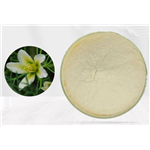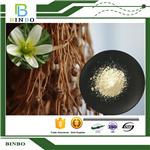Description
Harmine (343-27-1) is a selective competitive and reversible inhibitor of MAO-A (IC50?= 8 μM).1?Harmine is a potent and specific inhibitor of both the kinase activity and autophosphorylation of tyrosine during translation DYRK1A (IC50‘s: DYRKA1A = 33 nM; DYRKA1B = 166 nM; DYRK2 = 1.9 μM; DYRK4 = 80 μM).2,3?Inhibits self-renewal and promotes differentiation of glioblastoma stem-like cells (GSLC’s) possibly via inhibition of Akt phosphorylation.4?Harmine has also been shown to possess antimicrobial, antifungal, antiplasmodial, antitumor, antioxidant, antimutagenic and antigenotoxic properties.5?Inhibits osteoclast differentiation and bone resorption via downregulation of c-Fos and NFATc1 induced by RANKL.6
Chemical Properties
yellow to slightly green crystalline powder
Uses
Harmine Monohydrochloride is an anti-viral agents for the treatment of EV71 infection. It inhibits enterovirus 71 replication by targeting NF-κB pathway.
Purification Methods
The hydrate crystallises as fluorescent crystals from water. The anhydrous salt has m 319o. [Beilstein 23/12 V 237.]
References
1) Wouters (1998)?Structural Aspects of Monoamine Oxidase and its Reversible Inhibition?Current Medicinal Chemistry,?5?137
2) Seifert?et al. (2008)?DYRK1A phosphorylates caspase 9 at an inhibitory site and is potently inhibited in human cells by harmine; FEBS J.,?275?6268
3) Gockler?et al. (2009)?Harmine specifically inhibits protein kinase DYRK1A and interferes with neurite outgrowth; FEBS J.,?276?6324
4) Liu?et al. (2013)?Harmine hydrochloride inhibits Akt phosphorylation and depletes the pool of cancer stem-like cells of glioblastoma; J .Neurooncol.,?112?39
5) Patel?et al. (2012)?A review on medical importance, pharmacological activity and bioanalytical aspects of beta-carboline alkaloid ‘Harmine’; Asian Pac. J. Trop. Biomed.,?2?660
6) Yoneazwa?et al. (2011)?Harmine, a β-carboline alkaloid, inhibits osteoclast differentiation and bone resorption in vitro and in vivo; Eur. J. Pharmacol.,?650?511





